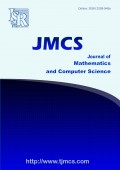Comparison Between Topological Properties of Hyperx and Generalized Hypercube for Interconnection Networks
-
3779
Downloads
-
4900
Views
Authors
Sadoon Azizi
- Department of Mathematics and Computer Science, Amirkabir University of Technology, Tehran, Iran.
Naser Hashemi
- Department of Mathematics and Computer Science, Amirkabir University of Technology, Tehran, Iran.
Mohammad Amiri Zarandi
- Department of Mathematics and Computer Science, Shahid Bahonar University, Kerman, Iran.
Abstract
In order to design an interconnection network, it is essential to have a comprehensive understanding about properties and limitations of the network. These properties and limitations are characterized by the topology of the network. Since a topology sets constraints and costs, it plays a critical role in all interconnection networks. Different topologies have been proposed for interconnection networks in literature. The Generalized Hypercube is one of the oldest topologies that can be mentioned. Recently a group of researchers at HP Lab have introduced a new topology for these networks, called HyperX. Despite of many similarities between these two topologies, there are significant differences between their performances and costs. It seems that this important issue has been neglected in contexts of interconnection networks. In this paper, we compare HyperX and Generalized Hypercube topologies under some key topological measures. We show that HyperX is somehow better than Generalized Hypercube in the sense of topological properties.
Share and Cite
ISRP Style
Sadoon Azizi, Naser Hashemi, Mohammad Amiri Zarandi, Comparison Between Topological Properties of Hyperx and Generalized Hypercube for Interconnection Networks, Journal of Mathematics and Computer Science, 9 (2014), no. 2, 111-122
AMA Style
Azizi Sadoon, Hashemi Naser, Zarandi Mohammad Amiri, Comparison Between Topological Properties of Hyperx and Generalized Hypercube for Interconnection Networks. J Math Comput SCI-JM. (2014); 9(2):111-122
Chicago/Turabian Style
Azizi, Sadoon, Hashemi, Naser, Zarandi, Mohammad Amiri. "Comparison Between Topological Properties of Hyperx and Generalized Hypercube for Interconnection Networks." Journal of Mathematics and Computer Science, 9, no. 2 (2014): 111-122
Keywords
- Topological properties
- HyperX
- Generalized Hypercube
- Interconnection Networks
- Performance.
MSC
References
-
[1]
W. J. Dally, B. Towles, Principles and practices of interconnection networks, Morgan Kaufmann Publishers, (2004)
-
[2]
J. Kim, High-Radix Interconnection Networks, PhD Thesis, Stanford University (2008)
-
[3]
J. Kim, W. J. Dally, D. Abts, Flattened butterfly: a cost-efficient topology for high-radix networks, In ISCA '07: Proceedings of the 34th annual international symposium on Computer architecture, San Diego, California, USA, (2007), 126-137.
-
[4]
J. H. Ahn, N. Binkert, A. Davis, M. McLaren, R. S. Schreiber, HyperX: Topology, Routing, and Packaging of Efficient Large-Scale Networks, Proceedings of the Conference on High Performance Computing Networking, Storage and Analysis, (2009), 1-11.
-
[5]
L. N. Bhuyan, D. P. Agrawal, Generalized Hypercube and Hyperbus Structures for a Computer Network, IEEE Transactions on Computers, 33 (1984), 323 – 333.
-
[6]
J. Dégila, B. Sansò, A Survey of Topologies and Performance Measures for Large Scale Networks, IEEE Communications Surveys and Tutorials Magazine, Fourth Quarter, 6 (2004), 18 - 31.
-
[7]
C. Leiserson, Fat-trees: Universal Networks for Hardware Efficient Supercomputing, IEEE Transactions on Computers, 34 (1985), 892-901.
-
[8]
R. P. Grimaldi, Discrete and combinatorial mathematics: an applied introduction, 5th edn. Addison Wesley, Reading (2004)
-
[9]
S. Azizi, F. Safaei, N. Hashemi, On the topological properties of HyperX, The Journal of Supercomputing , 66 (2013), 572-593.
-
[10]
E. Abuelrub, A Comparative Study on the Topological Properties of Hyper-Mesh Interconnection Network, Proceedings of World Congress on engineering, London, UK, 1 (2008), 9-5.
-
[11]
B. Li, A. Ganz, Virtual Topologies for WDM Star LANs - the Regular Structures Approach, in INFOCOM’92. Eleventh Annual Joint Conference of the IEEE Computer and Communications Societies, (1992), 2134-2143.

